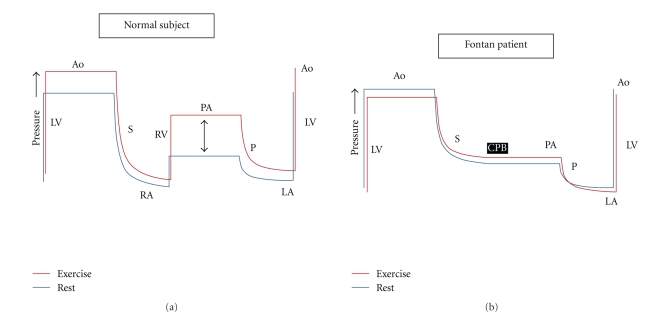Figure 1.
Theoretical schema to illustrate circulatory pressure changes in normal and Fontan patients at rest and during exercise. In the normal circulation, pressure is generated in the systemic ventricle (LV) to produce flow in the aorta (Ao) and systemic circulation (S). Pressure dissipates across the systemic microcirculation such that right atrial (RA) pressures are low. The pre-pulmonary pump (RV) provides the pressure to generate the flow in the pulmonary artery (PA) which then dissipates in the pulmonary circulation (P) but is sufficient to maintain preload in the left atrium (LA). During exercise, systemic vascular resistance falls such that there is little increase in mean LV pressure requirements. However, more substantial pressure increases are required in the RV (purple arrow), and these pressure requirements increase with exercise intensity. In the Fontan patient (below), the cavopulmonary bypass (CPB) does not provide any contractile force and, therefore, flow through the pulmonary circulation is dependent on the pressure difference between the RA and LA. During exercise, trans-pulmonary flow can only be augmented by reductions in pulmonary vascular resistance. Beyond mild to moderate exercise, pulmonary vasodilation is maximal and flow increases require a pre-pulmonary pump. Without this, pulmonary pressure does not rise, trans-pulmonary flow does not increase, LA pressure (preload) does not increase, and cardiac output cannot supply the metabolic demands of exercise.

